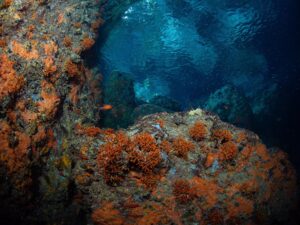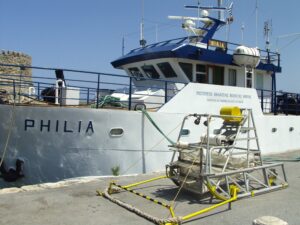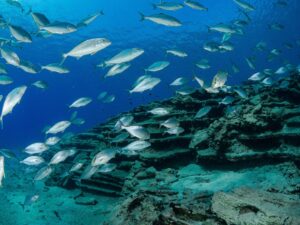Marine biodiversity
Key research areas
Microbial ecology, Coastal marine biodiversity and ecosystem functioning, Biodiversity hot-spots & extreme habitats, Benthic boundary layer, Population connectivity and local adaptation
We use every current approach to assess biodiversity and ecosystem functioning in the marine environment, including field observation and documentation, non-destructive/non-invasive census, collection of biological samples, genetic and genomic approaches, analysis and modelling. All levels of biological diversity are addressed, from prokaryotes to megafauna and from the individual to habitats and ecosystems, in local and global scales of observation. Through integration of the latest methods in marine biodiversity data management, analysis and dissemination, we advance scientific knowledge and develop novel scientific and technological approaches and products.
- Microbial ecology: microbial communities are the most important functional components of marine ecosystems, both as free-living and as symbionts/associates to complex holobionts. By assessing their diversity through fine-scale molecular approaches (metabarcoding, metagenomics and metatranscriptomics) we gain an insight into their identity (who?); their spatio-temporal distribution (where? when?); functional role (what?); and shifts in response to environmental fluctuations. In addition to sampling and wet-lab methods, microbial ecology data and metadata are collected and integrated to address the afore-mentioned who, where, what questions.

- Coastal marine biodiversity and ecosystem functioning: we conduct field surveys and laboratory experiments to establish baseline knowledge of marine biodiversity, as well as the effects of the major drivers such as climate change, biological invasions and anthropogenic pressures such as eutrophication and pollution, over-harvesting, and alteration of the physical habitats. Moreover, we develop protocols, methods of analysis including models, electronic services and virtual laboratories integrated in Research Infrastructures, to assess their shift in time. This is an entirely inter-disciplinary approach combining conventional taxonomic, ecological and biogeographic approaches with experimental and molecular data.

- Biodiversity hot-spots & extreme habitats: focused biological research on key marine habitats characterized by high - and often unknown - biodiversity and endemism, is one of the pivotal research areas of IMBBC. Our research embraces the description of new species, identification of taxa with potential for bioprospecting, understanding of ecosystem functioning and organism response to extreme environmental gradients, in habitats which are difficult to access (e.g. marine caves, coralline reefs and deep-water assemblages). Conventional taxonomy, combined with modern approaches, is also a research field which adds essential knowledge in identification of novel taxa.

- Benthic boundary layer: new methodologies are developed for the study of Benthic Boundary Layer (BBL) macrofauna (including mostly hyperbenthic organisms, i.e. crustaceans) as well as the relevant physical and biogeochemical processes. Because this ecosystem component is not easily captured by using conventional benthic or pelagic samplers due to their swimming mobility, we have constructed and applied improved and modified innovative sampling gears in order to evaluate the role of hyperbenthic communities with respect to pelagic, epibenthic and infaunal ones as well as to nutrient regeneration, carbon cycling and energy transfer to higher trophic levels.

- Population connectivity and local adaptation: understanding how abiotic factors affect population structuring and gene dispersal can provide detailed information concerning the dispersal and the pathways of species. Discovering the causes that influence local adaptation can be the answer to a number of challenges of modern marine research as well as to targeted protection and conservation activities in order to ensure best-fitness of a population, especially in changing conditions (e.g. climatic change, habitat destruction, introduction of alien species).

Related Content
|
Recent Posts
- Special Issue “Marine Biodiversity Observatory Systems” – in the Journal of Marine Science and Engineering (MDPI). Deadline for manuscript submission: 28 February 2021 https://www.mdpi.com/journal/jmse/special_issues/Christina_marine_biodiversity_observatory_systems
- Special Issue “Marine Benthic Biodiversity of Eastern Mediterranean Ecosystems” to the Journal of Marine Science and Engineering. Deadline for manuscript submission: 30 December 2023 https://www.mdpi.com/journal/jmse/special_issues/benthic_mediterranean
- New paper: Unpublished Mediterranean records of marine alien and cryptogenic species, published in BioInvasions Records: Through an initiative to collect, harmonize and make such unpublished data for marine alien and cryptogenic species in the Mediterranean Sea available, a large dataset comprising 5376 records was created. It includes records of 239 alien or cryptogenic taxa (192 Animalia, 24 Plantae, 23 Chromista) from 19 countries surrounding the Mediterranean Sea. https://www.reabic.net/journals/bir/2020/2/BIR_2020_Katsanevakis_etal.pdf
- Interview of Dr Christina Pavloudi on the recent Pinna nobilis mortality in PATRIS newspaper https://www.patris.gr/2019/08/09/ti-afanizei-tis-pines-apo-tis-thalasses-tis-mesogeioy/
- New Collective Article Series in Mediterranan Marine Science journal: This series includes new records of rare marine species and/or information on the spatial distribution of species of special interest (e.g. protected and threatened taxa). Photos of the species and coordinates of the sites they were found (in decimal degrees) are necessary. See below the first article of the series: Gerovasileiou V et al. (2020) New records of rare species in the Mediterranean Sea (May 2020). Mediterranean Marine Science, 21: 340-359. https://doi.org/10.12681/mms.22148 Author Guidelines: https://ejournals.epublishing.ekt.gr/index.php/hcmr-med-mar-sc/about/submissions#authorGuidelines
- New paper: Spatial and temporal community composition changes of Cumacea (Crustacea: Malacostraca: Peracarida) from the soft-sediment habitats of the Mediterranean coast of Israel.
https://imbbc.hcmr.gr/wp-content/uploads/2023/09/2023-Lubinevsky-MMS-48.pdf - MARBEFES – comprehensive approach to understanding reasons and sharing knowledge on biodiversity changes in European seas, presentation by Dr Koulouri at 10th EuroGOOS Internationa Conference, 3-5 October 2023, Galway, Ireland in relation to ecosystem services https://eurogoos-conference2023.marine.ie/event/133655:eurogoos-international-conference-2023
- MARine Biodiversity and Ecosystem Functioning leading to Ecosystem Services (MARBEFES): Stakeholder Engagement in Heraklion Gulf, Crete, Greece), presentation by Dr Koulouri at 10th EuroGOOS Internationa Conference, 3-5 October 2023, Galway, Ireland in relation to Greek stakeholders of Heraklion Gulf
https://marineinstitute.clr.events/attachment/650c584935057536614604




























